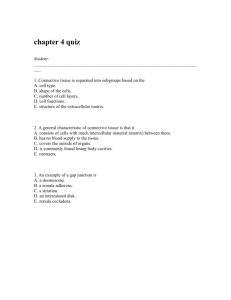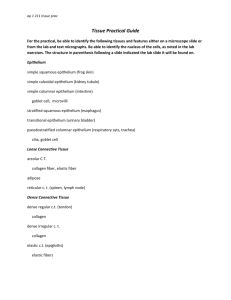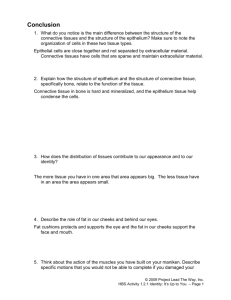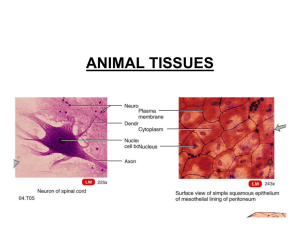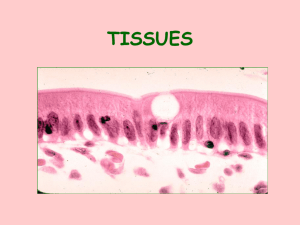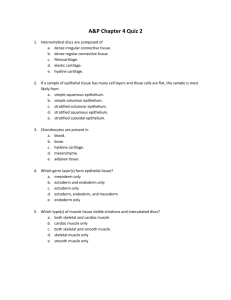Ch 4 Answers to End-of-Chapter Questions
advertisement
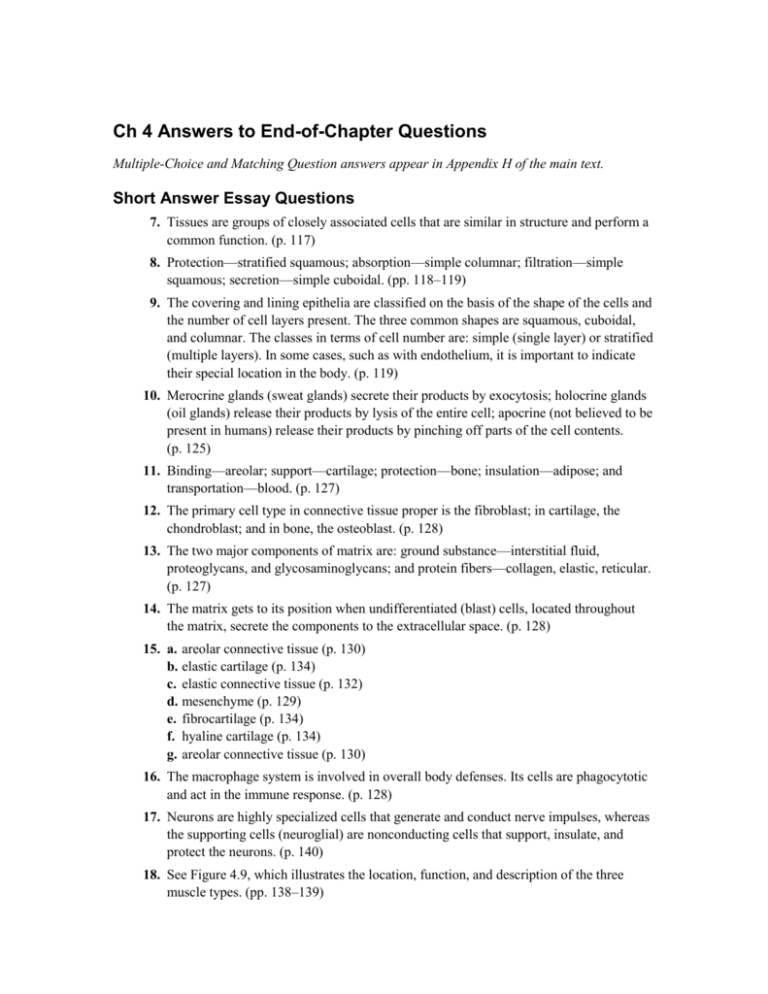
Ch 4 Answers to End-of-Chapter Questions Multiple-Choice and Matching Question answers appear in Appendix H of the main text. Short Answer Essay Questions 7. Tissues are groups of closely associated cells that are similar in structure and perform a common function. (p. 117) 8. Protection—stratified squamous; absorption—simple columnar; filtration—simple squamous; secretion—simple cuboidal. (pp. 118–119) 9. The covering and lining epithelia are classified on the basis of the shape of the cells and the number of cell layers present. The three common shapes are squamous, cuboidal, and columnar. The classes in terms of cell number are: simple (single layer) or stratified (multiple layers). In some cases, such as with endothelium, it is important to indicate their special location in the body. (p. 119) 10. Merocrine glands (sweat glands) secrete their products by exocytosis; holocrine glands (oil glands) release their products by lysis of the entire cell; apocrine (not believed to be present in humans) release their products by pinching off parts of the cell contents. (p. 125) 11. Binding—areolar; support—cartilage; protection—bone; insulation—adipose; and transportation—blood. (p. 127) 12. The primary cell type in connective tissue proper is the fibroblast; in cartilage, the chondroblast; and in bone, the osteoblast. (p. 128) 13. The two major components of matrix are: ground substance—interstitial fluid, proteoglycans, and glycosaminoglycans; and protein fibers—collagen, elastic, reticular. (p. 127) 14. The matrix gets to its position when undifferentiated (blast) cells, located throughout the matrix, secrete the components to the extracellular space. (p. 128) 15. a. areolar connective tissue (p. 130) b. elastic cartilage (p. 134) c. elastic connective tissue (p. 132) d. mesenchyme (p. 129) e. fibrocartilage (p. 134) f. hyaline cartilage (p. 134) g. areolar connective tissue (p. 130) 16. The macrophage system is involved in overall body defenses. Its cells are phagocytotic and act in the immune response. (p. 128) 17. Neurons are highly specialized cells that generate and conduct nerve impulses, whereas the supporting cells (neuroglial) are nonconducting cells that support, insulate, and protect the neurons. (p. 140) 18. See Figure 4.9, which illustrates the location, function, and description of the three muscle types. (pp. 138–139) 19. Tissue repair begins during the inflammatory response with organization, during which the blood clot is replaced by granulation tissue. If the wound is small and the damaged tissue is actively mitotic, the tissue will regenerate and cover the fibrous tissue forced to bridge the gap. When a wound is extensive or the damaged tissue amitotic, it is repaired only by using fibrous connective (scar) tissue. (pp. 142–143) 20. Ectoderm—epithelium and nervous; mesoderm—connective, muscle, and epithelium; endoderm—epithelium. (p. 144) 21. Adipose and bone tissue are similar in that both tissues are connective tissues with a rich blood supply and are used for nutrient storage. They are different in their relative amounts of extracellular matrix and location of nutrient storage. Bone has ample extracellular matrix, and this is the location of nutrient storage. Adipose tissue has little extracellular matrix, and stores nutrients within the cells. (pp. 130, 136) Critical Thinking and Clinical Application Questions 1. No, his recovery will likely be slow. Cartilage heals slowly because it lacks the blood supply necessary for a quick, efficient healing process. (p. 132) 2. The skin is subjected to almost constant friction, which wears away the surface cells, and is charged with preventing the entry of damaging agents and with preventing water loss from the body. A stratified squamous epithelium with its many layers is much better adapted to stand up to abrasion than is simple epithelium (single-layer cells); also the stratified epithelia regenerate more efficiently than simple epithelia. Finally, keratin is a tough waterproofing protein that fills the bill for preventing desiccation and acting as a physical barrier to injurious agents. Because a mucosa is a wet membrane, it would be ineffective in preventing water loss from the deeper tissues of the body. (p. 119) 3. If ligaments contained more elastic fibers they would be more stretchy; thus joints would be more flexible. However, the function of the ligaments is to bond bones together securely so properly controlled joint movement can occur. More elastic ligaments would result in floppy joints in which the bones involved in the joint would be prone to misalignment and dislocation. (p. 132) 4. Adenomas and carcinomas are derived from epithelium, because epithelial tissues remain mitotic throughout life. This is not the case for nervous and muscle tissue, and some forms of connective tissue. Also keep in mind that the prefix adeno- indicates a glandular origin, which is epithelial tissue. (p. 119) 5. Whereas “white” fat stores nutrients, “brown” fat uses its nutrient stores to produce heat, and actually weighs less than white fat. Brown fat occurs only in limited areas of the body, whereas white fat is found subcutanueosly anywhere in the body. Keep in mind that brown fat is found mainly in infants and cannot be converted from white fat. (p. 130) 6. Beef tenderloin is skeletal muscle. Cow tripe is digestive smooth muscle. (p. 138)
